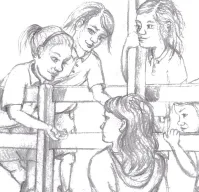Drawing Perspectives Together: What Happens When Researchers Draw With Children?
— Julie Spray —

“When only children draw, or perform, or play in our research, we risk reinforcing these activities as “childish” and establishing rigid binaries of child participant and adult researcher that overlook the insights we might gain as adult participants and child researchers. We forget to ask ourselves that multi-valent question that Christensen (2004) heard from her child participants: “who are you?” What kind of person are we making ourselves for child participants, and how will this person influence the data we generate together?”
Visual Anthropology Review, 2021, p21
lesson plan resource: Drawing together to practice reflexivity in research methods
Drawing together invites attention to the social and relational dynamics and meanings of the research methods we use. This activity is designed to get students to identify and reflect on the identities and relationships that are generated through research. It is useful for strengthening reflexive practice that is important for research with any kind of participant, not just children.
View the lesson plan resource here
Abstract
Reflecting on drawing together, a methodological intervention I developed through two child- centered ethnographic projects, I explore what happens when researchers draw together with children. While anthropologists of childhood have called for critical attention to the use of child- friendly participatory methods such as drawing, few have considered how researchers participate in these methods. Yet drawing is embedded with value- laden cultural notions of age and social status. Soliciting children’s drawings for research is therefore a social act that produces identities and relationalities. I argue that researchers must make the nature of their participation a methodological choice rather than an unexamined default.

Access the full-text here


